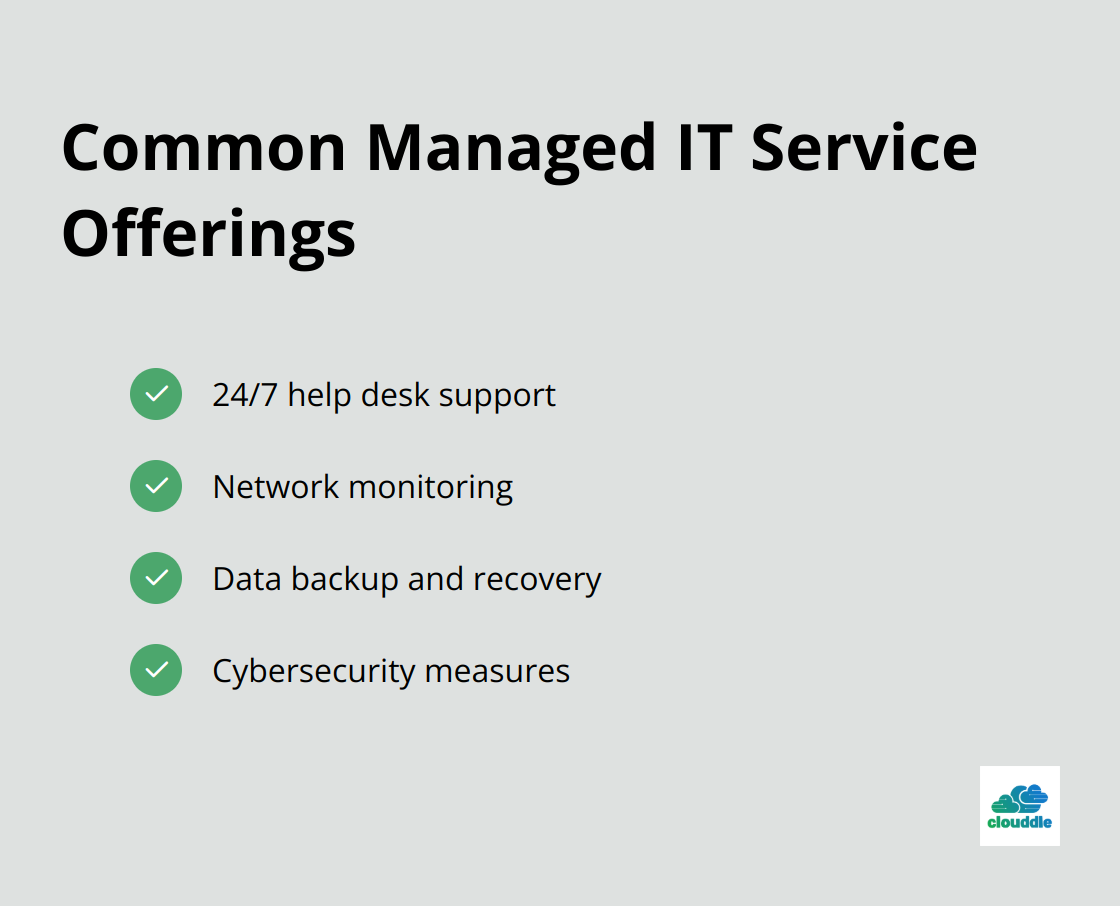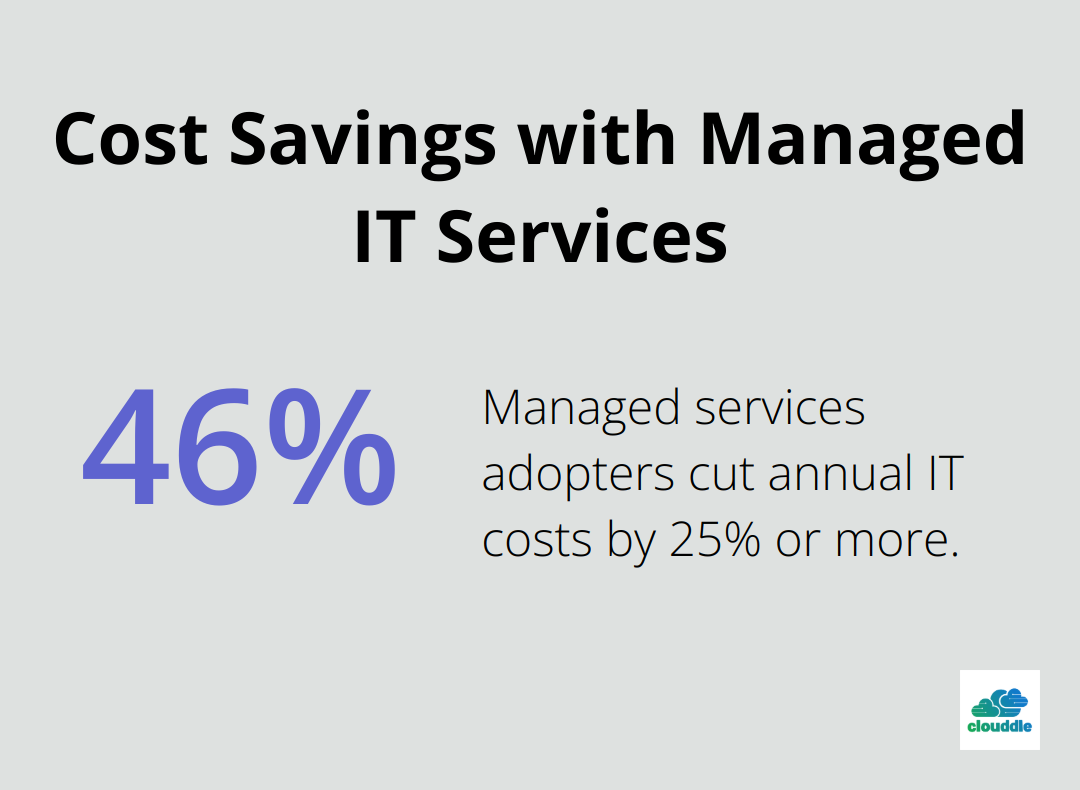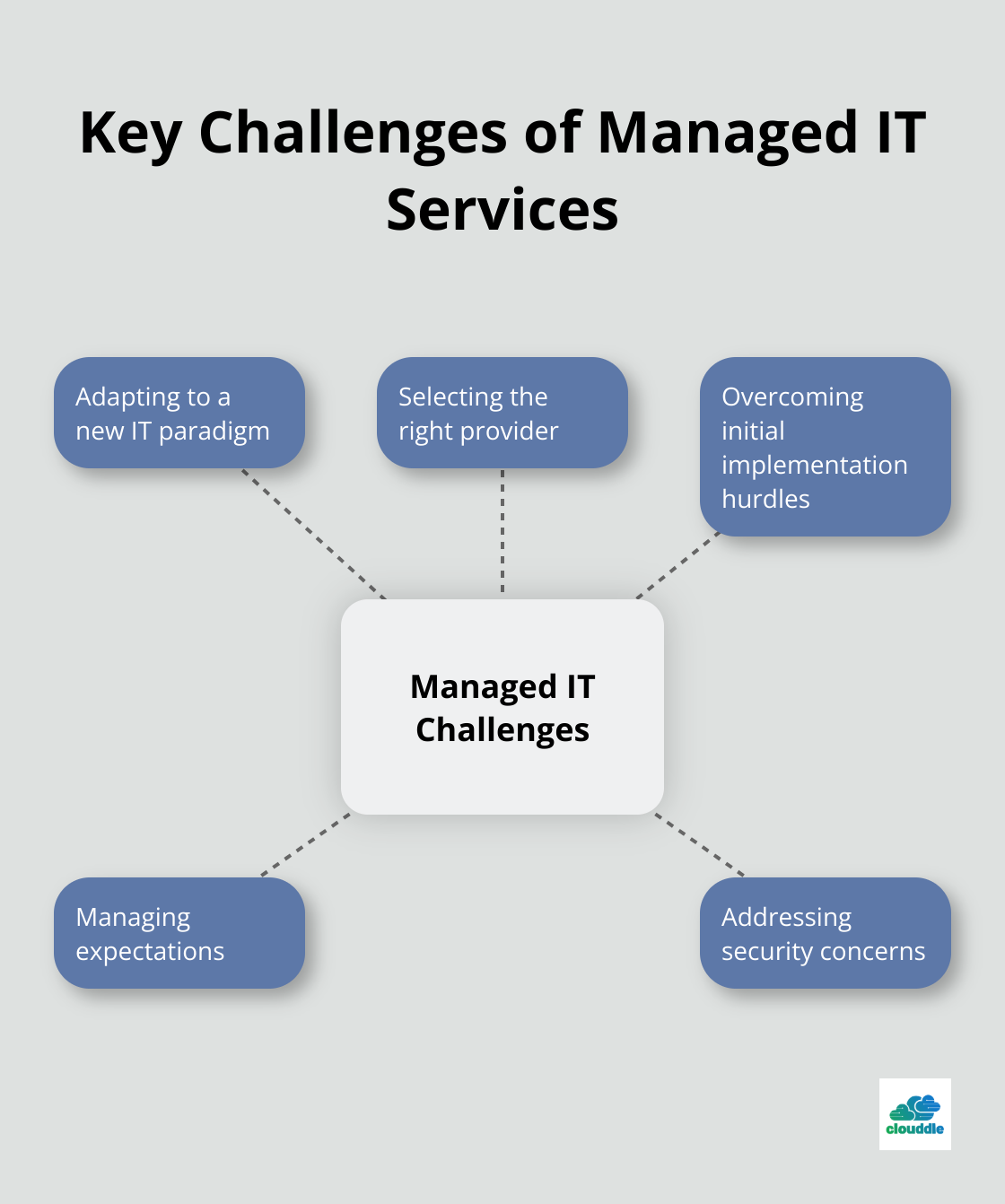In today’s fast-paced business world, managing IT infrastructure can be a daunting task. Many companies are turning to managed IT services as a solution.
At Clouddle, we’ve seen firsthand how these services can transform businesses. This post will explore the top 10 benefits of managed IT services and help you decide if it’s the right choice for your organization.
What Are Managed IT Services?
Definition and Scope
Managed IT services represent a strategic approach to outsource a company’s technology needs. This model has transformed businesses across various industries. Managed IT services encompass a wide range of technological needs, including network management, cybersecurity, cloud services, and hardware maintenance. The focus extends beyond problem-solving to proactive monitoring and maintenance, which prevents issues before they impact business operations.
Common Service Offerings
Most managed IT providers offer a core set of services. These typically include:

- 24/7 help desk support
- Network monitoring
- Data backup and recovery
- Cybersecurity measures
Some providers expand beyond these basics to offer industry-specific solutions. For example, specialized services exist for sectors such as hospitality, multi-family dwelling, and senior living.
Managed IT vs Traditional IT Support
The key difference between managed IT and traditional IT support lies in their approach. Traditional IT support operates reactively – you call when a problem occurs. In contrast, managed IT takes a proactive stance. It involves continuous system monitoring to identify and address potential issues before they cause downtime.
The pricing model also differs significantly. Traditional IT support often charges by the hour, which can result in unpredictable costs. Managed IT services can be priced based on various models, each offering different levels of service and flexibility.
Access to Expertise
Managed IT services provide access to a broader range of expertise. Instead of relying on one or two in-house IT staff, companies gain access to a team of specialists with diverse skills and experience. This proves particularly valuable for small to medium-sized businesses that can’t afford to maintain a large in-house IT department.
Tailored Solutions
Many managed IT providers (including industry leaders) offer customized solutions to meet specific business needs. This tailored approach ensures that companies receive the exact services they require, rather than a one-size-fits-all package.
The benefits of managed IT services extend far beyond simple tech support. In the next section, we’ll explore the specific advantages that make managed IT services a game-changer for many businesses, from cost savings to enhanced security measures.
How Managed IT Services Transform Your Business
Cost Reduction and Predictable Budgeting
Managed IT services offer significant cost savings for businesses. A CompTIA study reveals that 46% of managed services adopters cut their annual IT costs by 25% or more. This reduction stems from the elimination of in-house IT staff, hardware investments, and unexpected repair costs.

The fixed monthly fee model of managed IT services allows for more effective budgeting. This predictable pricing structure helps businesses avoid surprise expenses that can disrupt financial planning.
Downtime Minimization through Proactive Maintenance
System downtime can prove catastrophic for businesses. Gartner estimates the average cost of IT downtime at $5,600 per minute. Managed IT services combat this issue through continuous monitoring and proactive maintenance.
Service providers identify and resolve potential issues before they escalate into system-wide failures. This approach significantly reduces downtime, keeping businesses operational. Companies using managed IT services report high levels of uptime.
Access to Cutting-Edge Expertise and Technology
Managed IT services provide access to a team of experts well-versed in the latest technological advancements. These professionals bring diverse skill sets and experiences, allowing businesses to benefit from a breadth of knowledge impractical to maintain in-house.
For example, a hospitality industry client implemented a state-of-the-art guest Wi-Fi system through their managed IT provider. This enhancement improved customer satisfaction and generated additional revenue streams.
Managed service providers often partner with leading technology vendors, giving businesses access to cutting-edge solutions at preferential rates. This access can provide a significant competitive advantage, especially for small and medium-sized businesses.
Enhanced Security and Compliance Measures
With cybersecurity remaining a critical concern, managed IT services offer robust security measures to protect businesses from evolving threats.
These measures include advanced firewalls, intrusion detection systems, regular security audits, and employee training programs. Managed IT providers also stay current with the latest compliance requirements, ensuring businesses meet industry standards and regulations.
A senior living facility achieved HIPAA compliance and implemented stringent data protection measures through their managed IT provider. This effort safeguarded sensitive resident information and mitigated potential legal issues.
The transformative power of managed IT services extends beyond these benefits. In the next section, we’ll explore potential drawbacks to consider when evaluating managed IT services for your business.
Challenges of Managed IT Services
Adapting to a New IT Paradigm
The transition to managed IT services often requires a significant shift in organizational mindset. Many companies struggle to relinquish direct control over their IT infrastructure. A CompTIA survey revealed concerns about various security issues, including malware, hacking, data loss, and social engineering attacks like phishing.
To address these issues, companies should establish clear communication channels and schedule regular check-ins with their service provider. This approach helps maintain visibility into IT operations while leveraging expert management.
Selecting the Right Provider
The choice of a managed IT service provider can make or break the experience. A mismatch often leads to frustration and suboptimal results. Poor service quality is a significant factor in businesses switching managed service providers.
To mitigate this risk, companies must thoroughly vet potential providers. They should look for providers with experience in their specific industry and a proven track record of successful partnerships. (For example, businesses in the hospitality sector might seek providers who specialize in that field.)
Overcoming Initial Implementation Hurdles
The initial transition period to managed IT services can present challenges. Some businesses experience disruption during the initial implementation of managed services.
To minimize disruptions, companies should work closely with their chosen provider to develop a comprehensive transition plan. This plan should include a detailed timeline, clear responsibilities, and contingencies for potential issues. Many successful transitions involve a phased approach, which gradually transfers services to the provider.
Managing Expectations
Some organizations expect immediate results from managed IT services. However, the full benefits often take time to materialize. Companies should set realistic expectations and understand that the transition is a process, not an instant fix.
Regular performance reviews and open discussions about progress can help align expectations between the business and the service provider. This approach ensures both parties work towards the same goals and can address any issues promptly.
Addressing Security Concerns
While managed IT services often enhance security, some companies worry about entrusting their data to a third party. To alleviate these concerns, businesses should inquire about the provider’s security measures, certifications, and compliance standards.
Companies should also consider implementing additional security protocols (such as multi-factor authentication and regular security audits) to complement the provider’s efforts. This collaborative approach to security can result in a more robust defense against cyber threats.

Final Thoughts
Managed IT services offer numerous advantages for businesses across various industries. The 10 benefits of managed IT services we explored demonstrate their potential to transform operations, boost efficiency, and drive growth. Companies must weigh these benefits against potential challenges such as the initial transition period and the need to adapt to a new IT paradigm.
Businesses should evaluate their current IT infrastructure, long-term goals, and industry-specific needs when considering managed IT services. It’s important to assess the potential return on investment, considering both immediate cost savings and long-term strategic advantages. Choosing the right managed IT service provider is paramount to success.
We at Clouddle specialize in providing tailored managed IT solutions for industries such as hospitality, multi-family dwelling, and senior living. Our Network as a Service (NaaS) offering combines networking, entertainment, and security, allowing businesses to streamline operations and increase revenue without initial investment. Many businesses find that the benefits of managed IT services outweigh the potential drawbacks, giving them a competitive edge in today’s digital landscape.


